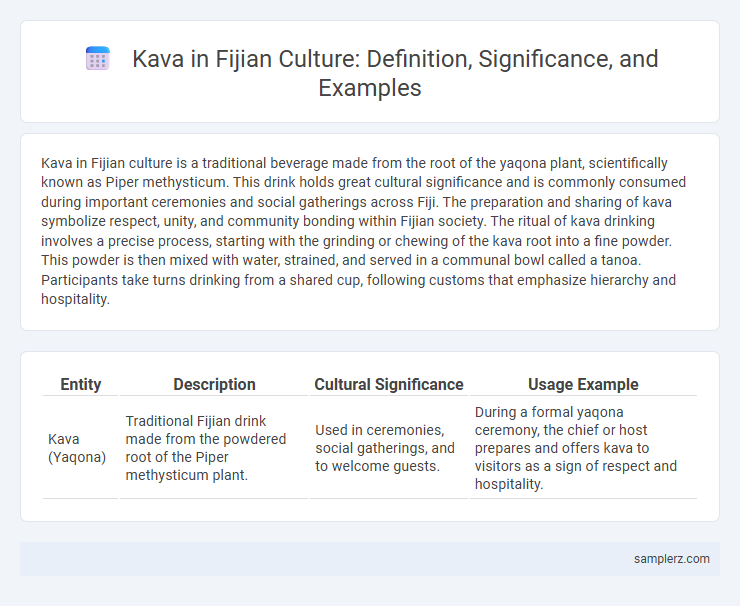Kava in Fijian culture is a traditional beverage made from the root of the yaqona plant, scientifically known as Piper methysticum. This drink holds great cultural significance and is commonly consumed during important ceremonies and social gatherings across Fiji. The preparation and sharing of kava symbolize respect, unity, and community bonding within Fijian society. The ritual of kava drinking involves a precise process, starting with the grinding or chewing of the kava root into a fine powder. This powder is then mixed with water, strained, and served in a communal bowl called a tanoa. Participants take turns drinking from a shared cup, following customs that emphasize hierarchy and hospitality.
Table of Comparison
| Entity | Description | Cultural Significance | Usage Example |
|---|---|---|---|
| Kava (Yaqona) | Traditional Fijian drink made from the powdered root of the Piper methysticum plant. | Used in ceremonies, social gatherings, and to welcome guests. | During a formal yaqona ceremony, the chief or host prepares and offers kava to visitors as a sign of respect and hospitality. |
Introduction to Kava in Fijian Culture
Kava, known as yaqona in Fijian, holds profound cultural significance as a traditional ceremonial drink made from the powdered root of the Piper methysticum plant. It plays a central role in social rituals, including welcoming ceremonies and communal gatherings, symbolizing respect, unity, and spiritual connection among Fijian communities. The preparation and consumption of kava follow established customs, reinforcing social hierarchy and fostering cultural identity across Fiji.
Historical Origins of Kava in Fiji
Kava in Fiji traces its historical origins to ancient Polynesian migrations, where it became deeply embedded in social and spiritual ceremonies. Archaeological evidence and oral traditions indicate that the plant was cultivated and consumed as a sacred beverage by Fijian chiefs and community leaders to foster unity and welcome guests. Its significance continues to symbolize respect and connection within Fijian culture, reflecting centuries-old customs passed through generations.
Traditional Kava Preparation Techniques
Traditional Fijian kava preparation involves using a wooden bowl called a *tanoa* and a strainer called a *turgi* to mix powdered kava root with water. The root is carefully pounded and strained multiple times to achieve the perfect texture and potency, preserving the ceremonial integrity of the ritual. This method reflects the deep cultural significance and communal aspects of kava drinking in Fijian society.
Kava Ceremonies and Social Gatherings
Kava ceremonies in Fijian culture are intricate rituals that play a central role in social gatherings, symbolizing respect and unity among participants. The preparation and sharing of kava, a traditional drink made from the powdered root of the Piper methysticum plant, follow specific protocols that reinforce social hierarchies and community bonds. These ceremonies often mark important events such as weddings, conflicts resolution, and the welcoming of guests, reflecting the deep cultural significance of kava in fostering communal harmony.
Symbolic Meanings of Kava in Fiji
Kava in Fijian culture symbolizes social unity, spiritual connection, and respect for ancestors, playing a central role in ceremonies and communal gatherings. Its consumption fosters a sense of harmony and tradition, reinforcing bonds between participants while honoring Fijian heritage. Serving kava represents hospitality and the transmission of cultural values across generations.
Role of Kava in Fijian Rituals
Kava holds profound cultural significance in Fijian rituals, serving as a sacred beverage used during ceremonies to symbolize respect, unity, and spiritual connection. The traditional preparation and communal drinking of kava, or yaqona, are integral to welcoming guests, sealing agreements, and honoring chiefs. This ritual reinforces social hierarchy and fosters community cohesion through its deeply rooted spiritual and cultural symbolism.
Kava Etiquette and Cultural Norms
Kava, a traditional Fijian drink made from the powdered root of the yaqona plant, is central to Fijian social and ceremonial life, embodying respect and community bonding. Strict kava etiquette governs its preparation and consumption, including the order in which participants receive the cup--typically starting with the most senior or important individual--and the ritualistic manner of clapping and silence observed during the ceremony. These cultural norms underscore the symbolic importance of respect, hierarchy, and unity within Fijian society.
Modern Adaptations of Kava Traditions
Modern adaptations of kava traditions in Fiji include the incorporation of kava into urban social events and contemporary ceremonies, blending traditional practices with modern lifestyles. Kava bars and lounges in cities like Suva serve as cultural hubs where both locals and tourists experience this ancient ritual in a relaxed setting. Innovations such as flavored kava drinks and packaged kava products make the traditional beverage more accessible and appealing to younger generations while preserving its cultural significance.
Kava’s Influence on Fijian Identity
Kava, a traditional Fijian drink made from the root of the yaqona plant, serves as a powerful symbol of social unity and cultural identity in Fiji. Rituals involving kava ceremonies reinforce communal bonds and respect for hierarchy, deeply embedding the practice within Fijian customs and daily life. Its influence extends beyond social gatherings, shaping Fijian values of hospitality, spirituality, and collective belonging.
Preservation and Future of Kava Culture in Fiji
Kava, deeply rooted in Fijian culture, remains vital for social ceremonies and traditional practices, symbolizing community and respect. Efforts to preserve kava culture in Fiji include cultivating native kava varieties and promoting sustainable farming techniques to ensure long-term availability. Educational programs and cultural festivals aim to engage younger generations, securing the future of kava as both a cultural emblem and economic resource.

example of kava in Fijian Infographic
 samplerz.com
samplerz.com